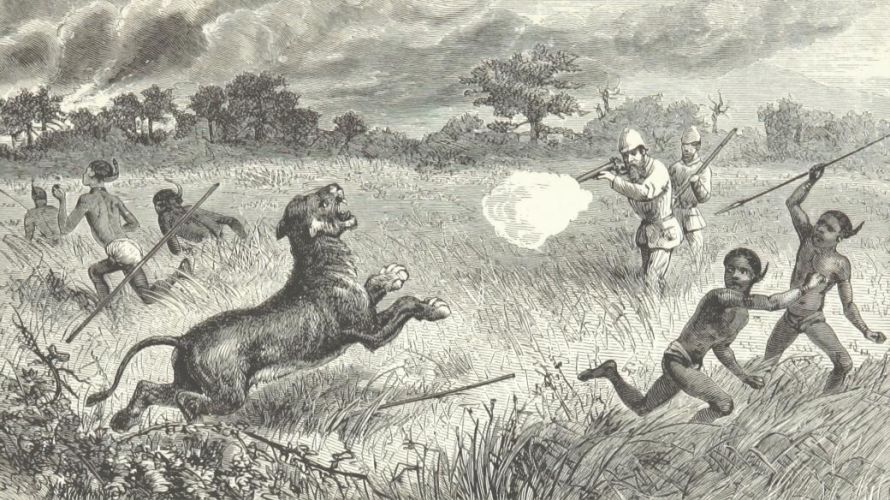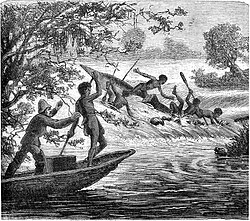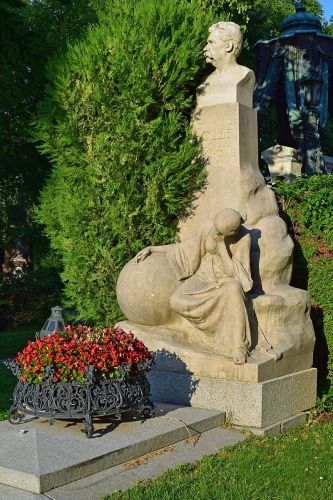
Emil Holub - traveler and ethnographer
Emil Holub (7 October 1847 – 21 February 1902) was a physician, explorer, cartographer, and ethnographer in Africa. Born in Holice in Easter Bohemia, (then within the Austrian Empire, now the Czech Republic). (from Wikipedia)
.jpg)
As a child, he read David Livingstone's African travelogue, which, according to his later words, strongly influenced him. Holub graduated in 1872 and received the title of Doctor of Medicine. On May 18, 1872, he set sail for his first trip to South Africa. He set sail from Southampton, England, and after a brief stopover in Cape Town, he disembarked in Port Elizabeth on July 8. Thanks to the recommendation of the Austrian consul there he began working as a doctor in European families. On August 26, 1872, he left to practice medicine in the town of Dutoitspan (now a suburb of Beaconsfield in Kimberley) among diamond prospectors. In March 1873, he joined a convoy of local hunters on a two-month journey - a "scientific safari" in the territory of the Bechuana tribes, where he gained his first experience with the natives and equipment. He compiled a natural history collection, which he sent to Náprstek in Prague in twenty boxes. (Vojta Náprstek was a philanthropist from Bohemia, nowadays his name has ethnographical Náprstkovo museum in Praha).
On 3 November 1873, he set off on a second scientific expedition, focused on collecting ethnographic materials, from which he returned on 7 April 1874. He explored the eastern edge of the Kalahari Desert and visited Shoshong, the main seat of the Bechuana tribe of the Bamangwat. He returned along the Limpopo River. He carried out a third expedition from 2 March 1875 to November 1877, during which he made a journey to the Zambezi River and made the first detailed map of the Victoria Falls area. He reached Shesheke, the main seat of the Lozi tribe (Bartost, Maruc), where he met their king Sipopo. Sipopo was a cruel tyrant, but Holub took a liking to him and provided him with the means to sail down the Zambezi River. However, it did not end very happily, as Holub and his native entourage were shipwrecked in the rapids, where his collections, travel diaries and several native rowers drowned.

 After this failure, Holub decided to return. On August 5, 1879, he set off on his return journey to Europe. He returned on October 18 of the same year and began lecturing throughout the Austro-Hungarian Empire and writing articles. He wrote and published the first book description of Victoria Falls, published in English in Grahamstown in 1879.
After this failure, Holub decided to return. On August 5, 1879, he set off on his return journey to Europe. He returned on October 18 of the same year and began lecturing throughout the Austro-Hungarian Empire and writing articles. He wrote and published the first book description of Victoria Falls, published in English in Grahamstown in 1879.
Thanks to the support of the public and the imperial court, he was preparing a second journey to Africa, during which he wanted to travel across the entire continent from Cape Town to Cairo.In case of complications, he would turn east to the Indian Ocean coast. He set sail on 22 November 1883 and landed in Cape Town on 22 December. He was accompanied by his wife Růžena (Rosa) and six men.
However, the British colonial authorities treated the expedition with incredible and apparently deliberate bureaucracy. Among other things, Holub had to pay customs duties on the expedition's equipment and was also denied the promised free transport on local railways.
The expedition headed from Cape Town via the Orange and Vaal rivers to the land of the Bechuana and Bamangwat in present-day Botswana and further through the territory of the Lozi (Maru), Supi (Mašupi) and Tonga (Matoki) to present-day Zambia. Many difficulties arose on the way, such as the death of draft oxen after consuming poisonous plants, and the expedition was then dependent solely on the services of indigenous porters.
In the summer of 1886, Holub left Tongan territory and set out for the land of the warlike Mashukulumb (Ilu), who wore peculiar spiky hairstyles. Holub was the first European to visit their territory. On August 2, 1886, the warlike Mashukulumb attacked Holub's camp near the village of Galulongy and killed Oswald Söllner,member of the expedition. At the same time, they stole a significant part of the supplies, destroyed the collections and diary entries. Holub, his wife and the remaining two assistants had to flee back to Tongan territory.
Despite all the difficulties, Holub managed to collect a lot of natural and ethnographic material and knowledge, which was appreciated in scientific circles in the Czech lands, Germany, France and England. He planned a third expedition to Africa in 1889. This time, at the instigation of Leopold II, he was to head to the Belgian Congo. His health no longer allowed him to do so.
.png)
.png)
.png)
.jpg)
He brought back an exceptionally rich and diverse collection, for which he became famous. A remarkable testimony to his travels is also a collection of several hundred drawings and watercolors. Holub was a skilled draftsman, with a sense of color and detail.
After returning from his second African journey, he published the book The Second Journey to Africa – From Cape Town to the Land of the Mashukulumbs. He organized two large exhibitions (1891 in Vienna and 1892 in Prague), which were visited by 190,000 visitors. Although the public interest was extraordinary, the exhibitions ended in financial losses due to the low admission fees. He was unable to obtain space for the permanent placement of his collections (around 13,000 objects) and began to sell them off abroad in parts, or to donate them to museums, scientific institutions and schools. In 1894 he went to the USA to lecture for two years, after returning he lived with his wife mainly in Vienna. In Africa he overcame malaria and other tropical diseases, which had a negative impact on his health.
 Tomb of Emil Holub in Vienna
Tomb of Emil Holub in Vienna
.png)
Thanks for reading
Margaret
Source: Czech Wikipedia
Museum of Emil Holub in Holice
